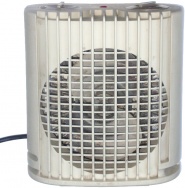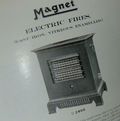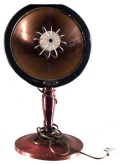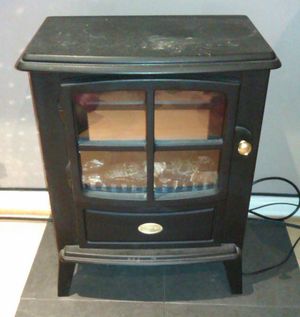Electric heating
This article compares the various types of electric space heating (room heating).
Radiation vs convection
Heat is given off in 2 possible ways, radiation and convection.
- Radiation in this context has nothing to do with nuclear radiation, it simply means that the heat rays travel in a straight line through air, just like light.
- Convection is the upward movement of heated air. Hence its not unusual to see convection heaters having a chimney shape to maximise air movement.
- Heat is also conducted, but this is a minor effect with space heating.
Red hot heating elements primarily radiate heat, dark less hot elements primarily convect. All radiant heaters produce a substantial amount of convected heat as well. Halogen heaters produce the highest percentage of radiated heat.
Radiated (or radiant) heat causes heating when it hits a solid object. This effect can warm humans in a cold environment with less heating of the surrounding air, and this effect is used to advantage in industrial situations to save heating power. However working in a cold room near a red hot element gives uneven & inconsistent heating, and the result is far from as comfortable as proper space heating.
All types
A few things apply to all of them.
- All electric heaters are 100% efficient, none of the heat goes outdoors.
- though electricity generation at the power plant is inefficient
- All are exempt from the annual inspections required of gas appliances in rented properties.
- Electric heating doesn't introduce any moisture into the house, as some types of fuel heating do.
Plug in heaters
All are much more expensive to run than all other mainstream heating options, at around 3x the energy cost of mains gas.
Thermostatic models prevent the room exceeding its temperature target, which often happens with non-thermostatic models - but only if the thermostat has compensation, and most don't. Without it a thermostat is incapable of maintaining anything like an even temperature. Properly thermostatic heaters cost less to run.
Plug-ins are best suited to just occasional use, where their high run cost and zero installation cost makes sense.
Fan heater
Usually fairly high power, fast heating, small, noisy, and a fire risk if covered.
There is always a tendency for dust to eventually block element airflow and catch fire. A metal case is an advantage in such a situation. An annual cleanout prevents the problem.
Convector
Medium power, medium size, no noise, a fire risk if covered but less so than fan heaters.
Electric Radiator
Lowish power, slow, large. Some only reach a moderate temperature, and are touch safe, no fire risk, and can be used to dry clothes. Some get hot enough to burn things. Relatively good around kids and the infirm, though they're heavyish and can be knocked over. More tolerant of minor water spills than most other portable heater types. Some have a radiator temperature control, some don't.
Some of these are described as thermostatic, but this doesn't mean they can maintain a steady room temperature, as the thermostat is inevitably attached to the hot heater casing. In practice it means the radiator reaches its operating temperature more quickly, and shouldn't overheat if covered with clothes.
Bar fire
These radiate heat from a red hot bar. Old models tend to be dangerous, with an exposed red hot live bar, inadequate guarding, and they tend to catch fire if something falls on them. They also seem to attract naughty kids that like to experiment. New models have better guarding, but still set fire to anything that falls on them.
Replacement heating bars are available if one fails, or the old bar element can often be repaired easily with a small bolt if the element wire breaks. But getting a safer heater is usually a better option.
Halogen heater
A more modern version of a bar fire, these use a red halogen lamp in place of the bare bar. The lamp is insulated rather than bare & live. The heat density isn't as high (400w per bar is typical), reducing the fire risk.
The halogen lamps last far longer than visible light lamps, but they don't last indefinitely. Replacement infra red lamps are available, and just slide into place once access is gained. Its worth taking the old one out before ordering a replacement, in case the contacts in the heater are burnt.
230v halogen IR lamps are usual, but the author has seen 110v ones used in 230v microwaves.
Tubular heater
Tubular heaters are low power (typically 60w to 300w) and low power density heaters designed to remain safe if a coat etc falls on them. The safest of all plug-in heater types. More tolerant of minor water spills than most other portable heater types.
These are used
- where items might fall on them, eg coats
- for pipe freeze protection
- to keep frost off greenhouses
- in airing cupboards
- to dry a small area with a damp or mould problem
- etc
The low power and temperature of these also make these usable for various hobbies that need some warmth.
Fire
Plug-in or fitted fires with wooden surrounds usually use bar elements to provide heat, and thus behave much like bar fires. The element is usually less exposed than basic bar fires, reducing fire risk.
These often use a red lightbulb to light fake coals. The heat from the bulb causes a slight convection current, which turns a lightweight slotwheel above the bulb. This causes the fake flame light effect. Fitting a lower power lamp (eg a CFL) stops the slotwheel rotation.
Heat pump
There's only one type of electric heating that can improve on 100% efficiency, and that's a heat pump. These use the power to pump heat from one place to another, and the power they use turns to heat too. When set up to pump heat from outdoors to inside, they can deliver 3x as much heat into a room as the power they use.
Since these take heat from outdoors, they must be installed.
With all heat pumps, the greater the temperature difference across them, the lower the efficiency they operate at. So severe cold weather much reduces heat output, just when its needed. This also makes them poor at driving a hot load, eg DHW or a thermal store.
Air source heat pump
Air source heat pumps are the cheapest and most common type of heat pump. These use a coil and fan to extract heat from the outdoor air.
A significant limitation of air source heat pumps is that efficiency and hence energy delivery falls as outdoor temperature falls. When the outdoor coil ices up, which happens somewhere in the region of 5°C and below, efficiency drops much further, making them ineffective heaters at such times.
Sometimes the units are reversable, able to operate as air conditioning in summer or as heaters in winter.
Ground source heat pump
The downside of a ground source heat pump is that a huge and costly layer of ground tubing needs to be laid. This takes a large area of ground.
These don't ice up like air source pumps, so continue to work all through winter. Since underground temp is higher than outdoor air temp at these times, they also work more efficiently.
Geothermal source heat pump
These have the same advantages as ground source heat pumps, but don't need the land. A bore hole is drilled to below the water table, and a long heat exchanger lowered into the water in it. These use less than a square foot of land.
Storage heaters
These heat up a pile of firebricks overnight on cheap rate electricity (using Economy 7 & similar schemes). During the day the stored heat is let out by movable flaps.
The main downside of storage heating is poor controllability, poor weather prediction, and sometimes they run out of heat before recharging time. Some newer models access weather forecasts in a bid to improve performance, how successful this is I don't know.
Storage heaters are bulky compared to radiators.
Storage heating is the second cheapest method of electric heating to run (only heat pumps cost less), and its suitable for all weathers, making it one of the most common choices. The run cost is still significantly higher than mains gas.
Note that daytime rates are often slightly higher than standard on Economy 7 type schemes, so the savings tend not to be quite as good as they appear.
Some of the oldest storage heaters had inadequate controls. If you have these in your house, you may find they warm the house during the day when you're at work, and the heat runs out in the evening when its wanted. Working like this is inefficient.
Heat bank
An electrically powered heat bank can be used to run wall mounted radiators. Installation cost is higher than wall mounted heaters, but other heat sources such as solid fuel or even solar can be added to the heatbank.
The heatbank stores heat, though the heat capacity is limited. This method is suitable for insulated flats with low heating needs. The ability to run on economy7 dramatically reduces bills compared to non-storage types. The storage effect also enables the peak heat output of the radiators to be much higher than wall mounted electric heaters of the same power as the tank heating element, thus these systems give faster house warm up. The central heating radiators are much less intrusive than electric storage heaters.
Under floor heating
UFH is available in 2 forms, piped hot water and electric. The electric version is about 3x as expensive to run.
The main advantages of UFH are that no heating equipment is visible, and it provides a comfortable warm floor. The warmth is especially appreciated with a tiled floor, and in bathrooms.
When installed on a ground floor it requires insulation underfloor. Usually this means taking up the existing floor, but there are thin insulation boards that allow heating to be laid on top of an existing floor, albeit with more heat loss, door trimming and often disruption to fitted kitchens.
UFH can't usefully be powered by cheap rate electricity. UFH has a significant time lag, so must be timed to turn on before the heat is needed. For these reasons, electric ufh is inherently not a cheap option. Heating cable failure can occasionally happen, and this creates additional expense if the floor is tiled or otherwise permanently finished.
Pipe based ufh driven by the central heating boiler is preferred wherever this is usable, as its much cheaper to run, and more reliable long term.
Halogen radiant
Wall mounted halogen radiant heaters produce radiant heat, red light and convected heat. The principle is the same as halogen plug-in heaters, and their shortcomings almost the same. They need to be mounted high up to reach all areas of the room, and the amount of red light given out at near eye level can cause some visual discomfort. For this reason they tend to see more use in commercial spaces. The high mounting also means hotter air at ceiling height, which is not efficient.
Quartz element
These are the predecessor of halogen heaters, and operate very similarly. They use an unsealed glass-like quartz tube a few feet long with a heating wire spiral inside it. Sometimes seen in bathrooms installed in the 60s or 70s.
Compared to halogen heaters they're longer, produce a little lower percentage of radiant heat, and take 10-20 seconds to warm up. Typically 250w - 500W, which really isn't enough power.
Obsolete types
Obsolete types of electric heating are still occasionally encountered.
Combination heater cookers
Various electric fires were produced that could be laid flat on their back and used as boiling rings, such as the Belling "Dinkie". Other fires had a trivet or rest on the top for keeping a kettle or teapot warm, such as the earlier Belling "Champion" heaters. Combination fires with a hotplate were produced. These could be used in bedsits and lodgings, night watchmen's huts, etc to provide heat and basic cooking facilities.
Ceiling radiant heat
Ceiling mounted radiant heaters are occasionally seen in 1960s properties. Since heat rises, these give poor performance, with rooms cool at the floor and hot near the ceiling. This increases energy use and losses.
Bowl heater
These were popular from the 1920s to 50s, but are rarely seen today. They are economical radiant heaters for use in cold houses, as much more of the radiant heat is directed to the person sitting nearby, compared to a bar fire. Usually rated at a few hundred watts, these are intended to take the chill off an otherwise unheated space.
They have all the defects of bar fires, plus instability, which increases the fire risk further, and lack of adequate guarding. Also their age makes them generally fail to meet even basic electrical safety standards. They have no real chance of passing a PAT test and should not be used.
Carbon lightbulb
Carbon filament lamps were once used as frost protection heaters in unheated bathrooms & toilets. A 200w carbon filament lamp provides about as much light as a 40w bulb, though with an orangey colour. The advantage is that no electrical wiring or socket is needed, the bulb is simply put in the bulbholder and left switched on.
In principle the same method can be used today with a 200w filament lamp and a dark lampshade, but plastic bulbholders are normally only rated to 100w. Gross overload can cause a fire. Uprating a pendant requires a metal/ceramic bulbholder and very high temp rated flex.
Other Applications
Frost protection
It requires much less energy to use a heating tape applied to frost-vulerable pipes rather than heat the whole room. Nevertheless space heating is sometimes used for frost protection.
Some heaters have thermostats that go low enough to provide freeze protection. 5°C is the usual setting, and allows a margin for temperature variation through the room.
Many heaters are under 1kW, or can be switched to this low a power setting. These can be run directly from a bimetal thermostat. Fan heaters have the advantage that they can be mounted above head height, blowing downwards.
Patio heating
Patio heaters can extend the outdoor season to some extent. However they're power hungry and most of the heat simply blows away. Opinions on the wisdom of patio heating remain mixed.
Heating people outdoors requires radiant heat, convected heat blows away. Most of the radiant heat misses its target. To maximise efficiency the heater should be as close to the people being heated as is safe.
The most efficient radiators are halogen heaters. Bar fires also radiate, but the percentage of heat radiated is less, and the percentage drops significantly in wind.
Towel rail
- Helps towels dry quicker
- Rails don't give enough heat to replace a radiator
- Can be powered by central heating or electricity
- Can be connected to a push timer switch giving eg 30/60/120 mins of heat
- Assorted element wattages available
- Half power setting can be added with a switch and suitably rated diode
- minimum diode voltage rating 600v
- diode current rating needs to be several times the rated heater current: check element cold resistance, calculate the current at 330v and ensure diode meets or exceeds this
- If not plumbed to central heating, can be filled with oil or water & corrosion inhibitor.
- If water, leave enough airspace in the water to prevent bursting on expansion, or don't tighten the bleed valve fully
Heat settings
Some heaters have both a selectable power setting and a thermostat. What difference does the power selection make:
On the lower power setting:
- lower peak temp possible
- longer warm up times
- fan noise goes on for longer
- more even temp distribution in the room
- slightly less thermostat hysteresis
- possible to use lower rated extension lead or run more appliances without overloading anything.
Safety features
Some heaters have additional safety features built in.
Handle: A handle on a panel heater enables it to be easily tied to something to prevent it falling over
Fall protection: the heater switches off if it falls over. This method has a switch on the underside.
For old heaters, check that the heating element is well enough guarded to prevent finger contact. Many fail on this point, and youngsters too often don't appreciate the risks.
Insulation
Where heating is to be used regularly, insulation should not be omitted. To do so is a false economy.



